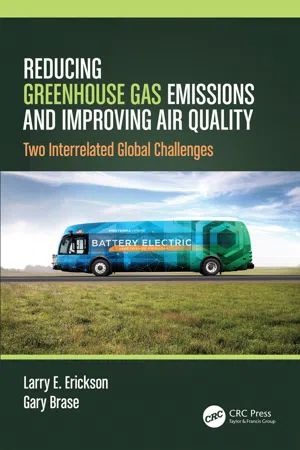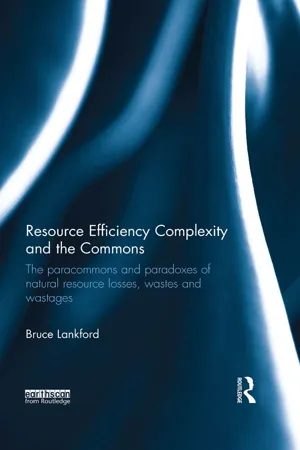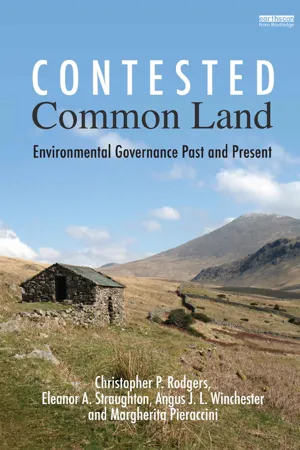Common Resources
Common resources are goods or services that are non-excludable but rivalrous, meaning they are available to all but can be depleted by use. Examples include fisheries, forests, and clean air. Common resources often face the challenge of overuse or depletion due to the difficulty in regulating access and usage, leading to the "tragedy of the commons" dilemma.
8 Key excerpts on "Common Resources"
- eBook - ePub
Environmental and Natural Resource Economics
A Contemporary Approach
- Jonathan M. Harris, Brian Roach(Authors)
- 2021(Publication Date)
- Routledge(Publisher)
...For example, in Scotland, trout-fishing rights on certain rivers are jealously guarded property. But it is difficult to parcel up every function of the river and define it as someone’s property. To some degree, the river is a common property resource —it is accessible to everyone and not subject to private ownership. Technically speaking, a common property resource is one that is nonexcludable because people cannot easily be excluded from using it. The other characteristic of a common property resource is that it is rival, meaning that its use by one person diminishes the quantity or quality of the resource available to others. common property resource a resource that is available to everyone (nonexcludable), but use of the resource may diminish the quantity or quality available to others (rival). nonexcludable a good that is available to all users, under conditions in which it is impossible, or at least difficult, to exclude potential users. rival a good whose use by one person diminishes the quantity or quality of the good available to others. Consider groundwater as an example of a common property resource. Anyone can access groundwater by drilling a well; thus, it is nonexcludable. But groundwater is rival because each user depletes the aquifer somewhat, leaving less water available to other potential users. How can a common property resource be managed to maximize social benefits? Is government regulation required to prevent the overuse of the resource, and, if so, what types of regulations can be effective? We address these questions using the example of an ocean fishery. The Economics of a Fishery A classic example of a common property resource is an ocean fishery. While inland and coastal fisheries are often governed by private, traditional, or government management systems, fisheries in the open ocean are typically open-access resources. An open-access resource is a common property resource that lacks any system of rules governing its use...
- eBook - ePub
Reducing Greenhouse Gas Emissions and Improving Air Quality
Two Interrelated Global Challenges
- Larry E. Erickson, Gary Brase(Authors)
- 2019(Publication Date)
- CRC Press(Publisher)
...The situation is, at this point, no longer just a common pool resource but rather a public good. Renewable Common Resources become public goods (at least partially) when maintaining core stock requires investment, and that investment is provided by the community of consumers. Both public goods and Common Resources are non-excludable; anyone can benefit from them. But economists consider public goods, unlike common goods, to be non-rivalrous: With sufficient investment it is possible for everyone to take part in the resource consumption. For instance, a fishery can be used to restock the waters with fish, replanting can restore a forest, and water treatment plants can provide clean water. (Just like there are non-renewable Common Resources, which are not the focus here, there are public goods that are not derived from Common Resources. Examples of these include media broadcasts and information on the Internet. These public goods come into existence entirely through the efforts of the community of users, and these are also not the focus here.) Public goods and common pool resources are often lumped together and also are frequently confused with one another. They are both theoretically and empirically distinct, though, and the differences have important consequences. Theoretically, as mentioned earlier, common pool resources and public goods are different in terms of their degree of rivalry. People can be sensitive to this difference and change how they behave in the two different types of situations (rivalrous versus non-rivalrous; Apesteguia and Maier-Rigaud, 2006). Public goods and common pool resources are also perceived to be very different in terms of the temporal sequence of events that defines each situation...
- eBook - ePub
Environmental and Natural Resources Economics
Theory, Policy, and the Sustainable Society
- Steven Hackett, Sahan T. M. Dissanayake(Authors)
- 2014(Publication Date)
- Routledge(Publisher)
...Moreover, resource systems having common-pool characteristics, such as the stocks of air, groundwater, stratospheric ozone, and marine fisheries, are difficult to partition as private property. In this chapter, we will look at the economics of common-pool resources and the tragedy of the commons in detail. In Chapter 6 we will look at marine fisheries management as a practical application of the economics of common-pool resources. Additional coverage of common-pool resources from the perspective of local self-governance is provided in Chapter 16. Renewable Resources The class of resources that is capable of replenishment over time. Excessive harvest can deplete the productive capacity of a renewable resource. Less obvious but no less important from an economic standpoint are the various ecosystem services such as fresh water provided by the hydrological cycle, fertility provided by topsoil, and oxygen provided by plants. Another vital ecosystem service is the sink capacity of the biosphere—its capacity to absorb human wastes. Examples of sink functions include the capacity of rivers, wetlands, and other bodies of water to absorb waste, and the capacity of aquatic and terrestrial ecosystems to absorb carbon dioxide generated as a by-product of the burning of fossil fuels. Ecosystem services can be thought of as the flow of benefits that derive from the stock of natural capital. The economics of ecosystem services is a new and emerging area of study that we will survey briefly. Allocating Nonrenewable Resources Examples of nonrenewable natural resources include: oil fields natural gas fields coal beds mineral deposits In fact, nonrenewable resources are in large part synonymous with mineral and fossil fuel energy resources. The term nonrenewable means that the resource system ultimately has a fixed stock (fixed size of total “reserves”) within the human time frame...
- eBook - ePub
Development Economics
Theory and Practice
- Alain de Janvry, Elisabeth Sadoulet(Authors)
- 2021(Publication Date)
- Routledge(Publisher)
...CHAPTER SIXTEEN Common Property Resources and Determinants of Cooperation Why Are There Common Property Resources? As we saw in Chapter 15, property rights are defined in terms of five cumulative rights (Ostrom, 2001). They are the rights to: access; extract; manage; exclude others; and alienate (sell or transfer). For these rights to matter, they have to be enforced. Open-access resources offer users only two rights: access and extraction. Common property resources (CPRs), also called common pool resources, give community members the rights of access, extraction, management, and exclusion. Under CPRs, the services of a resource such as fishing, grazing of animals, and the extraction of firewood or lumber from a forest are (1) collectively excludable (nonmembers are excluded, while members cannot be excluded), and (2) rival in use (the fish, forage, or lumber disappears with appropriation by one member), also called substractible. As can be seen in Figure 16.1, CPRs can be compared to private and open-access resources in that they are rival; and they can be compared to club goods in that they are collectively excludable. Figure 16.1 Definition of types of good: Use and access rules There are many CPRs in the world (Baland and Platteau, 1996)...
- eBook - ePub
- Bonnie Nguyen, Andrew Wait(Authors)
- 2015(Publication Date)
- Routledge(Publisher)
...However, because they can share the parks (and also the burden of paying for the parks), together it is socially optimal that they consume three parks. Because the good is non-excludable, consumers cannot be excluded from enjoying the public good even if they have not paid for it (this is called ‘the free-rider effect’). This makes it difficult for private firms to enforce payment and hence make profits from the sale of a public good; as a result, there is little to no provision of public goods by the private sector. The upshot of this is that there tends to be under-provision of public goods in the free market relative to the efficient quantity. As a result, public goods are often provided by the government, who can enforce payment for the public good through the taxation system. Indeed, governments in the real world tend to be responsible for providing national defence services, street lighting, parks, environmental quality and so on. 18.3 Common Resources and the Tragedy of the Commons Common Resources are often thought of as ‘partial’ public goods because they are non-excludable, but rivalrous. Examples of common resource goods might be: fishing stocks on the high seas; mineral deposits where there is no effective government oversight; or use of a road or a bridge that the government cannot, or chooses not to, restrict the use of. The market failure arising from Common Resources is over-exploitation. This problem is frequently referred to as the Tragedy of the Commons and is often described as follows. Suppose the residents of a village share a field where each may graze cattle. The field is non-excludable because no villager can be prevented from using the field to graze cattle, but rivalrous because grazing by one villager depletes the amount of grass available for the next villager’s cattle...
- eBook - ePub
The Economics of Property and Planning
Future Value
- Graham Squires(Author)
- 2021(Publication Date)
- Routledge(Publisher)
...With club goods as with benefits restricted to a specific group – such as by being a member of a trading block or using a toll road that isn’t congested. Common pool resources are those that are non-rivalrous and non-excludable but differ from pure public goods given the resource quality of being potentially overused or congested. As an example, deep-sea fishing has rivals in its exploitation but is not entirely excludable in terms of price. In fishing, the size and characteristics of the industry make it costly, but not impossible, to exclude potential beneficiaries from obtaining benefits from its use. ‘How’ to produce goods and services in making places will be determined largely by some combination of market signals and government intervention. The forces and decisions on what goods and services will be produced can therefore vary depending on space, with different places being subject to different contextual circumstances. For instance, using a simple housing example, a place with a greater national free-market ethos will tend to construct more dwellings as the market economy rises (and vice-versa). A place located in a nation with a greater state-controlled and less of a free-market approach would construct housing in more of a regulated and planned way...
- eBook - ePub
Resource Efficiency Complexity and the Commons
The Paracommons and Paradoxes of Natural Resource Losses, Wastes and Wastages
- Bruce Lankford(Author)
- 2013(Publication Date)
- Routledge(Publisher)
...Chapter 6 Distinctions between the commons and paracommons By employing efficiency as the lens through which to view natural resource systems, the paracommons can be distinguished from the ‘principal commons’ (Table 23). In this chapter I have categorised these distinctions into two sections; a) resource conservation and b) subtractability and competition for gains. With respect to the paracommons, this division into two sections and their order is artificial because it is the second section on the competition for salvaged losses that partially ‘solves’ the first section on resource conservation by retaining or sending them to the common pool. Prior to an explanation of some of those distinctions, I first address the term ‘principal’. The principal commons describes a natural capital common pool of resources subject to human withdrawal and consumption. These are the commons that the common pool resource (CPR) literature is mostly concerned with (Baden and Noonan, 1998; Dolšak and Ostrom, 2003b). They exhibit problems of ‘non-excludability’ (difficult to exclude users); and ‘subtractability’ (or ‘rivalry’, where in joint use, one user is able to subtract welfare from another). Examples of rivalry exist over fish from a freshwater lake, or over water drawn from a stream. Furthermore, I combine both stocks and flows as constitutive features of the ‘principal commons’. Although distinctions in ecological or economic systems between stocks and flows can be made (see Millennium Ecosystems Services and related literature (MEA, 2005; Mooney et al., 2009)) where a stock of a resource gives rise to portions that can be harvested as a flow, the central idea of a principal commons is of a linear flow of resources with waste as an externality to the system of consumption. Thus both the body of water in a dam and the dam's exit flow comprise ‘a principal commons’ with irrigation drainage as one of its ‘wastes’...
- eBook - ePub
Contested Common Land
Environmental Governance Past and Present
- Christopher P. Rodgers, Eleanor Straughton, Angus J.L. Winchester, Margherita Pieraccini(Authors)
- 2012(Publication Date)
- Routledge(Publisher)
...At the heart of all communal resources lies an inherent tension between individual self-interest and the communal good. This, of course, is the conflict at the heart of the ‘tragedy of the commons’, assumed by Hardin (1968) and many others to lead inevitably to the destruction of the resource in question. Notwithstanding the body of literature which has demonstrated that sustainable management of common pool resources (CPRs) is possible, the inherent contest between individual and communal interests remains a key feature of common land, distinguishing it from other property regimes. On common land there exists an essential paradox: no one individual can take sole control or dispose of the resource; yet the interests and actions of each individual are immensely powerful – potentially destructive – and must be carefully balanced by the community of users if the common is to be sustained. These inherent tensions frequently gained substance in day-to-day contests over the use of common land. Indeed, the property rights regime on common land contained within it a set of tensions between the rights of the owner of the soil and those having communal land-use rights. Not infrequently, the lord of the manor’s rights to game or minerals came into conflict with the tenants’ rights to grazing or to take vegetation. Managing a common as a breeding ground for game was not necessarily compatible with managing it for grazing; quarries could destroy pastures (e.g. Aldred, 1990, pp76–78, 124–126, 157–159); mining could lead to subsidence. Furthermore, different common rights were not always mutually compatible: the exercise of turbary rights could potentially conflict with pasture rights, as digging peat and turf could destroy the vegetation cover, for example, or lead to waterlogging...







